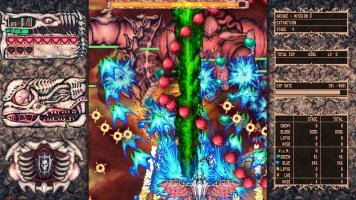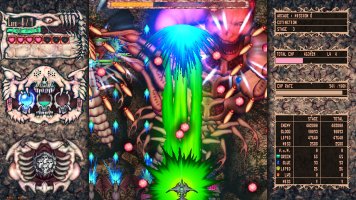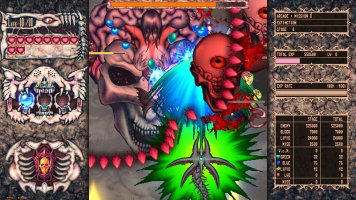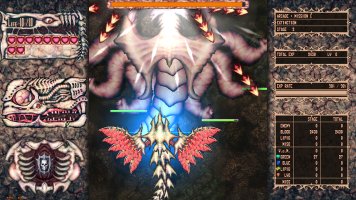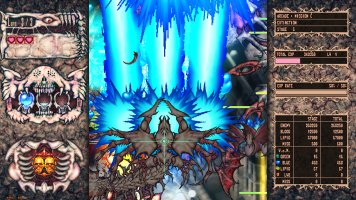Official Review
Set in a future where science has wiped out pleasure, sin, and crime, Angel at Dusk offers a fierce arcade bullet-hell game with a deeply disturbing futuristic body horror theme. Levels are made of twisted, oozing body parts held together by shiny sinew – a look that extends to the monstrous enemy ships. Most of the game's modes are packed with thick, intense bullet patterns, while complex overlapping systems reward risky play. Angel at Dusk is far from casual or cozy.
Yet with this recent creation – first out on PCs earlier this year – Akiragoya may have made one of the most approachable true arcade-style bullet hell games ever, without alienating devoted shmup fans. At its core, Angel at Dusk is a remarkably smart game in its design, writing, humor, and grasp of traditional shooting games. It knows the rules of shmup design well enough to know exactly which ones to bend – without breaking the formula's essence.
Many developers have tried to make arcade shooters more accessible – but games like Cuphead and CYGNI, while great in their own ways, stray so far from arcade roots that they offer very different experiences. Angel at Dusk, however, delivers a genuine arcade shooter full of complex intertwined game and scoring systems, rewarding intense action, and overwhelming waves of flashy bullets, with a soundtrack that boldly shakes you with styles like free jazz. It's completely authentic, yet welcomes a wide range of players.
This is clear in the incredibly detailed – and totally optional – opening tutorials, which take you from basic 2D movement to advanced techniques like 'figure-eight weaving' – a bullet-dodging method useful in boss fights across the genre.
So how did Akiragoya pull this off? Let's go back to knowing which rules to bend. Angel at Dusk doesn't try to reinvent the genre or add fancy new systems. Instead, two small changes to the usual formula make a big difference without being too disruptive. You can touch enemies without taking damage, and you can slowly earn extra lives.
These two tweaks might seem minor, but they perfectly enhance the game's core risk-reward mechanic. Blasting foes at close range showers you with green heart items, steadily filling your HP bar. Max out that bar, and you gain an extra life – something you can do multiple times per level. To survive a full playthrough, you'll want to get right up in the face of those grotesque enemies. It's a huge help that collisions don't harm your ship. However, by charging at opponents, you'll be putting yourself smack in the middle of bullet hell patterns at their most intense.
This means you need to shoot at point-blank range to earn lives and survive, which itself puts you in the game's most perilous spots. As a result, both newcomers and veterans are encouraged to play aggressively and experience the thrill of risking it all for big rewards.
The Arcade and Story modes follow a traditional structure, offering five linear vertical stages, each capped with a boss fight. Arcade mode requires you to choose a ship with a preset weapon loadout, while Story mode allows you to mix and match wide-shots, lasers, press-and-release bullet-cancelling barrages, and more. Chronicle mode presents a branching path structure, unlocking new level and boss variants, as well as fresh weapon options. Once you open a stage in Chronicle mode, you can revisit it anytime without replaying previous levels, making it ideal for shorter gaming sessions. Be warned though, Chronicles can get incredibly challenging.
In Arcade mode, the default 'very hard' difficulty can be one-credit-cleared (1CC'ed) on the first try by genre veterans, while newcomers can likely conquer it with some practice. Just as you're feeling proud of beating Angel at Dusk, it cheekily refers to that 'very hard' setting as its own 'very easy mode' – but don't worry, the next difficulty level up offers plenty of challenges for shmup enthusiasts.
Interestingly, Angel at Dusk might be better described as a 'systems shmup' rather than a 'scoring shmup'. While there are clever ways to rack up points – mainly through Raiden Fighters Jet-inspired medal chaining – success largely comes down to playing well enough to eliminate as many enemies as possible. To achieve this, you must explore all the interconnected play systems rather than mastering one central scoring mechanism.
Beyond the core mechanics, Angel at Dusk offers depth through its EXP system. As you play, you collect experience to level up your craft mid-flight. This reduces your hitbox and enhances your secondary weapon's missile barrage while charging. Both Chronicle and Story modes feature an intricate weapon upgrade and customization system. Some ships even have bombs, obtainable through green power-ups.
While there's a lot to grasp, Angel at Dusk excels at explaining its complexities. The game's ambitious tutorial showcases a deep understanding of the genre, playfully poking fun at some of its quirks while encouraging players. Minor translation hiccups actually add to the tutorial's otherworldly charm. It's more than just a guide – it's an essay on shmup design, a love letter to the genre's evolution and the rewarding experiences it offers.
The game's body horror elements, which can be grotesque and occasionally sexualized, might not appeal to everyone. However, Angel at Dusk shines in its gameplay, visuals, and audio. Performance is generally smooth, with only occasional stutters between stages when played in docked mode.
What sets Angel at Dusk apart is its ability to cater to players of all skill levels. It succeeds where many excellent shmups falter by being welcoming and empowering, even to those new to 2D shooters.
Conclusion
Angel at Dusk is a remarkable blend of weirdness and genre mastery. It's built on a deep understanding of shmups, with an intelligence and self-awareness that elevates the experience. While its theme may not resonate with everyone, it offers an authentic hardcore bullet hell experience, sharp wit, and engaging game systems. Its ability to welcome a wide range of players to a genuine shmup experience makes it one of the year's most exciting genre contributions.


